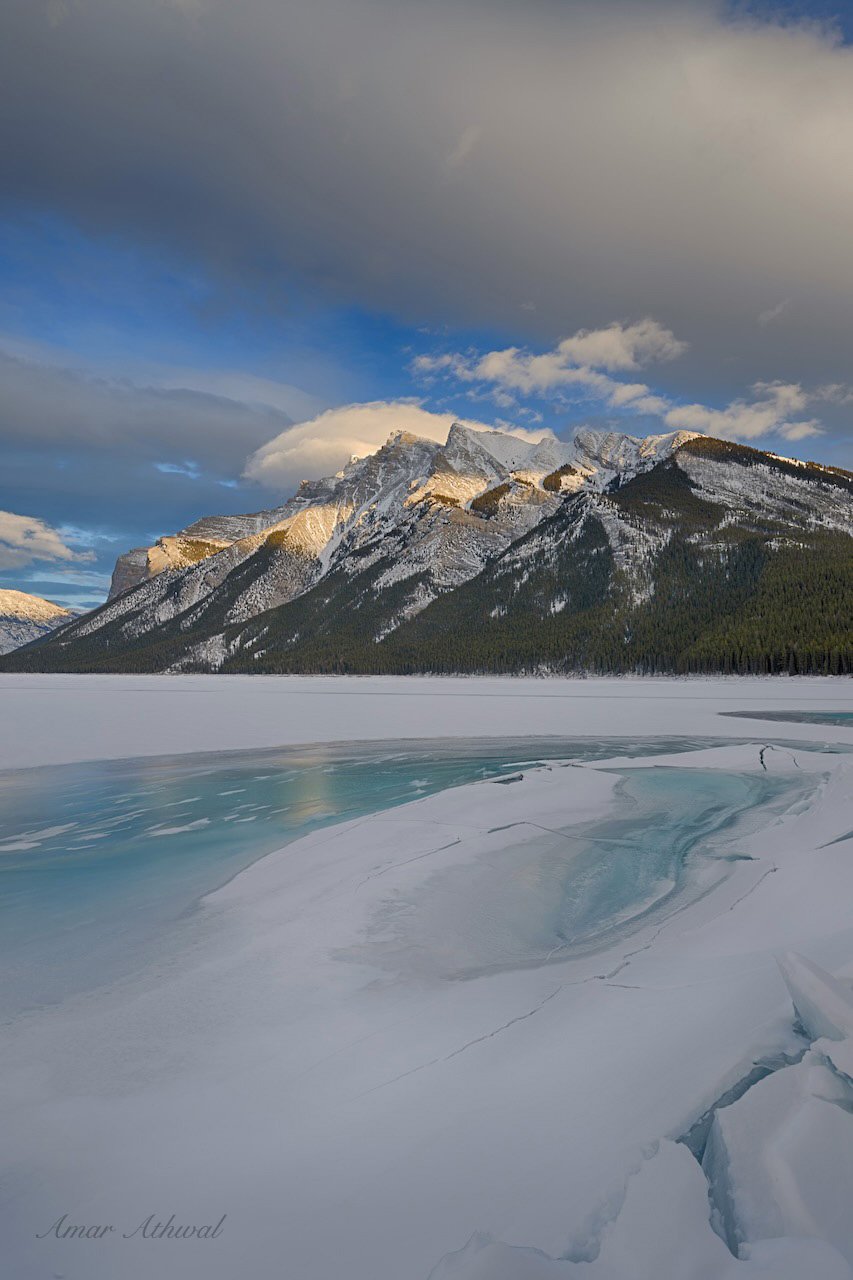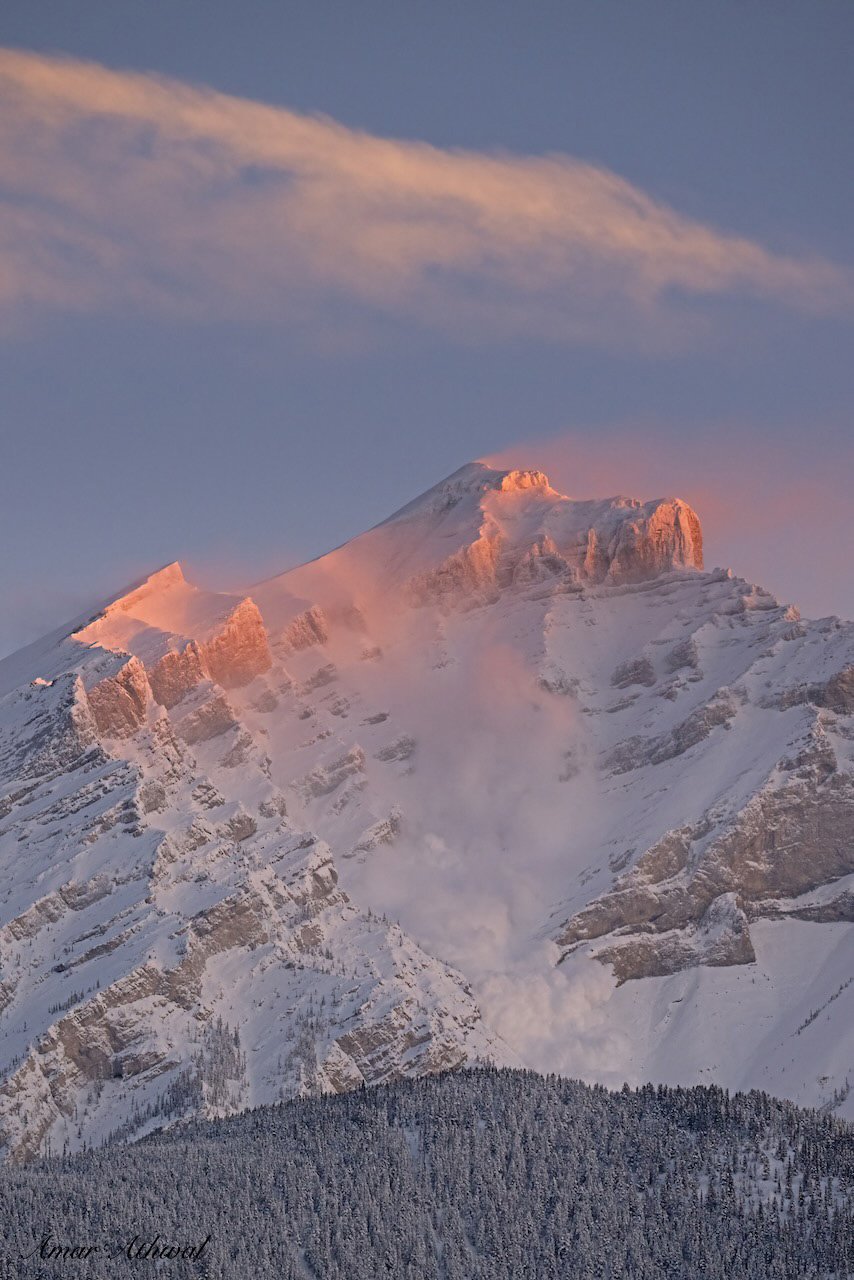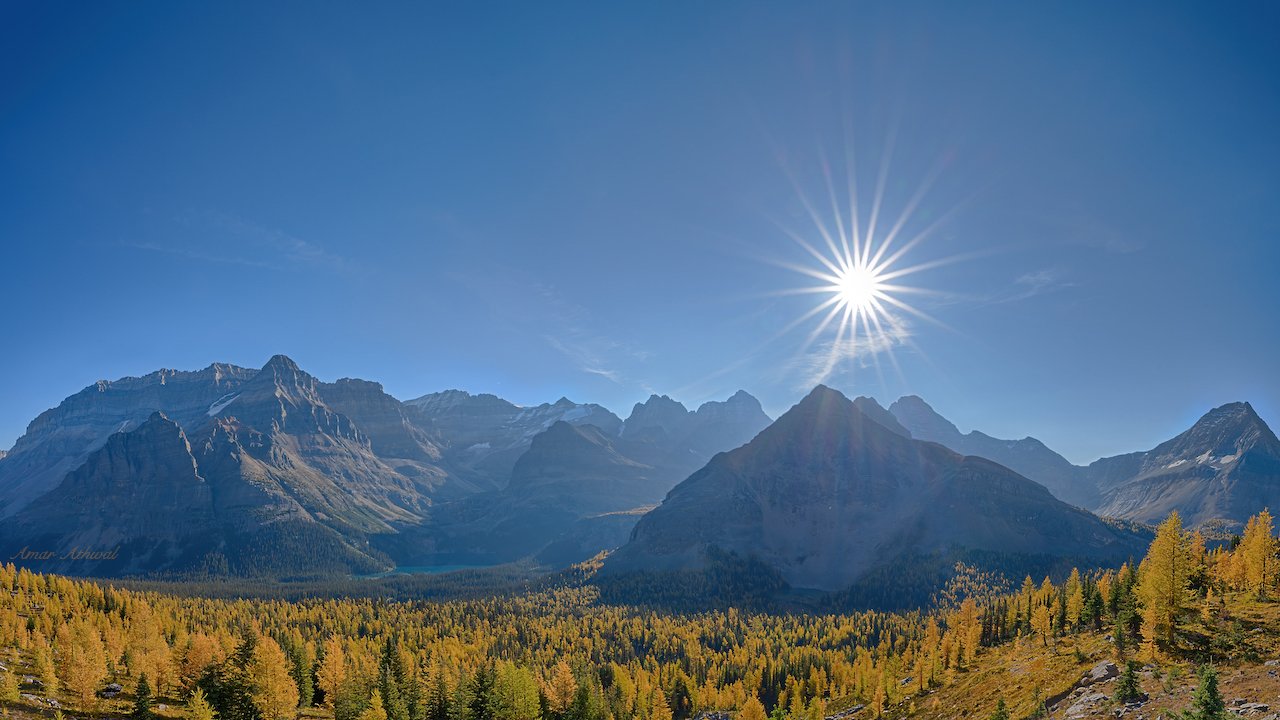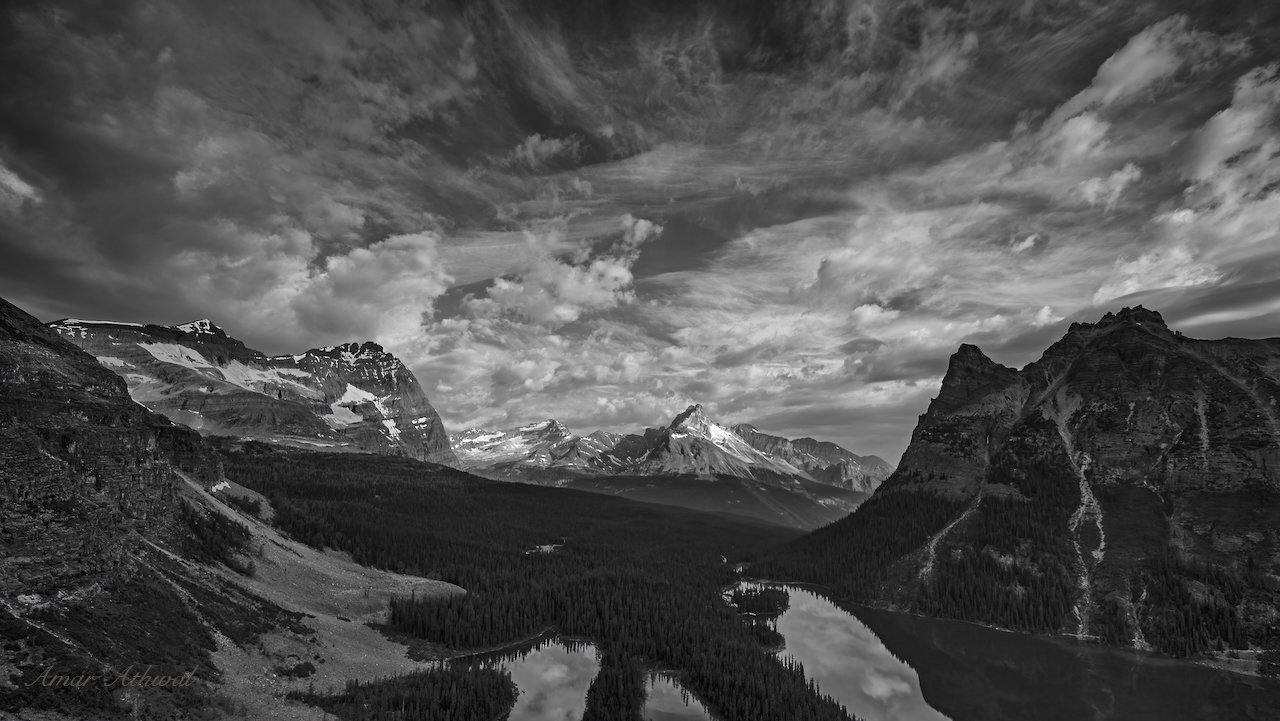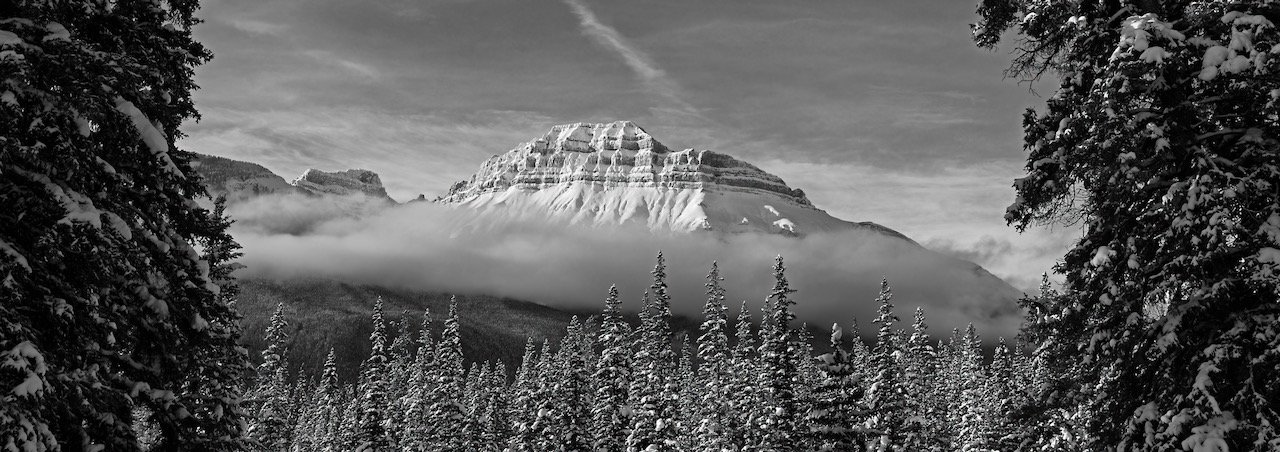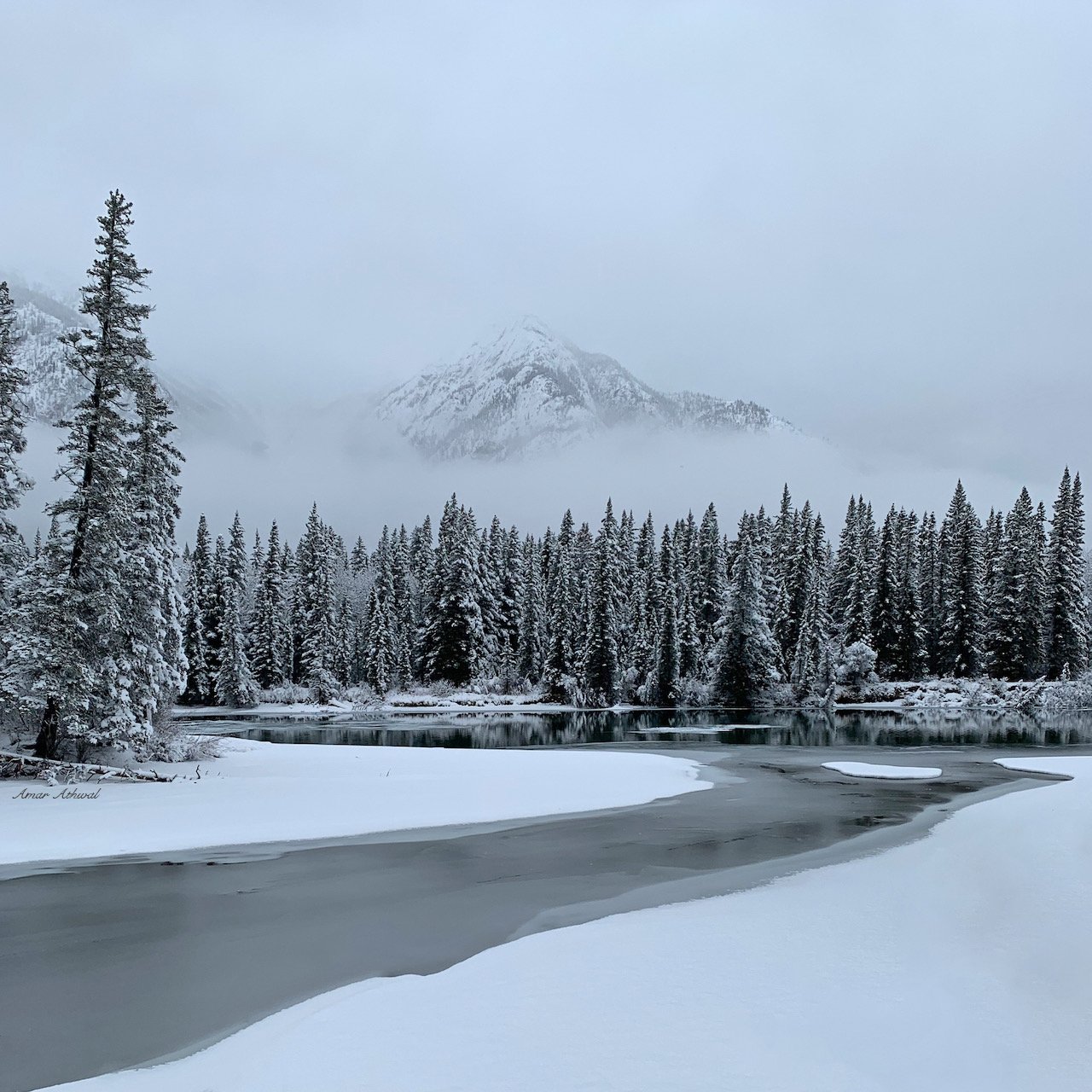Things are changing fast now as spring pushes through. This sunset picture was taken just a couple of weeks ago, as I was looking for a spot with some calm water. Well before the sunset, the sky was already showing some red colour. I just needed to find a spot where the wind would be blocked off by the landscape. The ice was getting weaker, so I also had to make sure I was taking little to no risk where I stood on parts of the frozen river. Just the morning before, about a hundred meters down the river from my location, over seventy elk had crossed the river. Two days after this picture, there was not enough ice for a coyote to cross in the same area. Warmer temperatures, open water absorbing more heat, longer days and the sun getting higher up in the sky each day. All factors helped to open the river for the incoming birds from the south. Even with the three nights of low temperatures we are currently going through, other than needing an extra layer, the day’s temperature is keeping the water open. Providing more places to observe waterfowls after the sunrises.
Mount Inglismaldie
If I could only give one reason why I go out in nature, it would be to feel better. No matter what my mood was before I stepped out, I always feel better after a walk on the trails. And I am sure many of you can relate to that. Studies are starting to back this up. Including one indicating the nature's colours green and blue reduces stress, improves our moods, brings us with positive emotions and brings down our anxiety levels. One study found that even after 40 seconds of looking at a green roof, we make fewer mistakes in a test. And in my case, making sure I can calculate the exact change for my chocolate purchase. These were just some of the things covered in November by The Guardian article titled: “The nature cure: how time outdoors transforms our memory, imagination and logic.”
Various indigenous communities across the world have learned there are many plants that can be used as medicine, and more is being discovered through research today. But one of the best cures is a simple walk in the park.
Fairholme Range
I rarely have people in nature pictures I take. When I do, other than at work or social gatherings, they are there naturally and are not aware they are getting their picture taken. It’s always in a public setting, and they are always looking away from the camera. Just like the pictures I take of nature, I let the events occur naturally and take pictures when the event in front of me becomes interesting. I think this would be my fourth picture I’m sharing as a “moment” with a person. I could have easily removed the person during post-processing. But I decided to leave the person in, like the trees and shrubs, the person gives a sense of scale to the picture. I was about 150 meters from the person who was also taking pictures of the sunrise, and the mountain range is about 14.5 kilometers from us. The lens tends to compress the space. There are many ways to take the picture, each photographer having their style and or personal preferences. As for having myself in the pictures I take. What can I say, I take a look at myself in the mirror in the morning, and I’m good for the day.
Mount Rundle
We get some crazy sunrises during the winter. They are even better when everything is covered with snow. So far, this year's winter wonderland days have been few and far between. For me, a crazy sunrise and sunset occur when it's so bright, it becomes a challenge to get the bright colours with some details in the clouds in an image. You often see this when a picture is taken of a sunrise or a sunset. Instead of the bright red colours, you get yellow and the image is lacking in details where it's the brightest. That is why it’s always easier when the mountains and the trees are covered with snow. Then the lights bounce off the snow, creating less of a brightness difference between the sky and the ground. This was a long sunrise in mid-December. The clouds went from dark red to bright red and then to bright yellow. The clouds were lit up for about 20 minutes before the light hit the north side of Mount Rundle. By then, I had stopped taking pictures and just watched the light show in front of me.
Cascade Mountain
Most of us only know about avalanches from what we hear on the news. Usually in a negative context. Avalanches, like wildfires, are a natural process. It occurs when a layer of snow collapses and slides downhill. Four factors cause avalanches: a steep slope, snow cover, a weak layer in the snow cover and a trigger. Triggers can be caused by wildlife, skiers and various human-caused ways to reduce danger on the slopes or in a valley containing roads and or railway tracks.
But avalanches like wildfire play a role in increasing biodiversity in the mountains. For example, studies were conducted in Austria by zoologists and entomologists. Natural avalanches tracks, particularly on the sunny south-facing slopes, are rich in butterfly species. As a result of the area being rich in plant diversity. These natural corridors, free of bushes and trees, become grassland or meadows connecting different habitats up and down the mountain.
Its increased diversity in plants and insects on these avalanche slopes helps to attract birds that take advantage of these ecosystems. Like the Fox Sparrows, MacGillivary’s Warblers, Hermit Thrushes and Calliope Hummingbirds to name a few. As well as the larger mammals, like the bears, They can more easily move around on the avalanche slopes looking for food or looking for an easy way to go from point a to b.
Mount Aberdeen
We humans have already figured out how to make time go by quickly. You just have to stay busy. It feels like this picture was taken just a couple of weeks ago. But when I looked at the date, it was the start of October. I was coming down from the Big Beehive using a safer route, still above the low clouds that were in the Lake Louise area. On the way up early that morning, I heard a Northern Pygmy Owl. But there was still not enough light to explore to see if I could see it. So, descending a different route, I was not going to have a chance at possibly seeing the owl. But the great views more than made up for that. For some of the views, I just had to stop and take my camera out to get their pictures. This one was one of them. The trees in front of me and Mount Aberdeen were all covered with fresh snow. It was a winter wonderland on the morning of October 1, 2023.
Mount Temple
You do all the planning to go for a hike, with the hopes of coming back with a few good pictures. Load up the camera equipment, a few extra layers, food and water, first aid kit and some odds and ends. You get an early start to the hike. But once you get there, as often happens, the weather has other plans. The hike was great but no pictures were worth saving. Then there are those days when the hike starts late due to weather. On your way to the trailhead you see the fog start to burn off as the light starts coming through the clouds. And then the right parts of the mountains light up to get the pictures you want to keep before you even start the hike. Once again, nature decides when to put on the show and you just have to be ready to click.
Sundance Range
After taking pictures in the direction of the sunrise, the sun was still rising behind the mountain range to the east. I did a 180 and looked toward the Sundance Range. There it was, a picture of a light blue sky, clouds covered with warm morning light and mountain range lit by the reflective light. The sunrise I hoped for. After taking the pictures, the camera was put away. All bundled up from the cold air, with the exception of the face feeling the cold wind passing by. I spent some time watching the surroundings wake up to the rising sun, before deciding to head down.
Fairholme Range
Visualizing what picture you want is an important part of photography. This step can also save you lots of time. By pre-visualizing, not only are you thinking about will the conditions in front of you will make for a good image. But also thinking can the camera pick up what our eyes are able to see. Our eyes still have a greater dynamic range than the best camera on the market, even more compared to our phone’s camera. The dynamic range is the ratio between the brightest and darkest parts.
During some sunrises and sunsets, the camera does not even come out of the pack if certain conditions are not met for a good image. During a full moon night, when your eyes can not only pick out the details in the moon, but also in the surroundings around you. With the camera, you will have to take multiple shots, exposing separately for the details in the moon and the ground. Then using an application on the computer to put different parts of each image together to create what your eyes were seeing. Even then, it will end up being different from what our eyes saw.
During the night or early in the morning or late in the day, there are flashes and portable lights you can use to get a half decent picture of wildlife. But that’s a terrible thing to do. Us humans are thrown off when a flash is used on us during the dark. Let along what the wildlife feels that have far more sensitive eyes than us. Last week, when I saw three red foxes at three separate locations as I was coming home in the dark, unless they were in my vehicle’s headlights, no picture was going to be taken. Later was the case. The camera stayed put.
For this image. I was coming back home when I saw the moon, clouds and the mountain range in the late evening light. I knew before even getting off the highway and getting on the Vermilion Lakes Road. I had an image in front of me waiting to be taken, where I needed to go and take it from and it was going to end up as a black and white image. Other than the trees in the foreground, which I wanted to be dark anyway, the peaks, clouds and the moon were under the same light. The camera was going to give me the image I was seeing. Making it black and white was my creative choice. Visualization and getting good images. The more you practice, the easier it gets.
Mount Rundle
The Canadian Rockies, like many other places in Canada, are not having their normal winter. Well, it’s the case for much of the world. The "new norm”. I have not had too many opportunities to get out in the morning and see everything covered with snow this winter. So far, we've had above-average temperatures and below-average snowfall. The last time we got a decent snowfall was in the later part of December, when this picture was taken. Luckily, I had the day off following the snowfall, getting out and taking pictures wherever I could. I When we had normal winters, I never wanted them to end. Now, I try to get the most out of each snowfall. When everything looks like a postcard to my eyes.
Moon
With photography, I am self-taught and only when I share some of my images, others see my work. I still need to find a way to get better at my passion. As always, new technology can only take you so far. Being critical of my work is very important for my images to keep improving. Almost all my time related to photography is spent taking pictures and then working on images that I don’t delete. At the very least, I can say. I do not make a conscious effort to copy other photographer’s images. When I do have time, I’m more likely to study and look at painting than photography. Also, luckily my mind is weird enough, as those who know me can verify. I have my unique perspective on the world around me. Playing a big role in all the final images.
Sometimes I know right away I got a good image, but the true test is when I look at it on the monitor. If I’m not sure, I’ll let it stay on the drive for a few days and then get back to it. In the end, if the image I have taken is not something I want to show others, it will be deleted. Unless I get that rare slightly out of focus image of a unicorn, that image will be saved until I get a sharper one.
The day before I got this image, I must have walked for half an hour waiting to be in the right position to get the picture of the moon coming over the Sawback Range. I got several looks of the moon and the peaks. I went home and uploaded the images. I ended up deleting them all. I thought I could do better. The next day the moon would be rising a little later over the same mountain range, but this time I wanted to be on the other side of the valley and have the moon right above Mount Ishbel. A peak that had a triangle shape on top. The possible image in my head was more balanced.
Twenty-four hours later, I was ready to try again. Just as the moon started to come over the range, in less than five minutes I was in the position to get the picture I wanted. There was no question it was going to be black and white, giving it a better contrast between the snow and rocks and helping to bring out the clouds. As always, never being fully satisfied. I already have ideas on how I can make the image even better in the future. Just need mother nature’s cooperation.
Golden Sunrise
Alpine larch, also called subalpine larch and lyall larch is a deciduous conifer species that grows higher on cool exposures than other trees. It grows in very cold, snowy, and windy environments. It remains small and stunted, but in wind-sheltered areas it can reach up to 29 m in height. For more than half of the season, the average temperatures are below freezing for this tree’s environment. The average precipitation for most of the alpine larch sites is between 800 and 1900 mm. Generally, the snowpack starts around these larch trees in late October and can linger with most stands until early July.
Most of the soil development in the alpine larch stands tends to be immature. Alpine larch sites have undergone alpine glaciation during the Pleistocene and have been deglaciated for less than 12,000 years. Due to a short, cool summer season as well as low soil temperatures and high acidity, the processes that can enrich the soil are limited. Alpine larch commonly grows on slopes covered with granite or quartzite talus, which were not previously surrounded by vascular plants. Vascular plant tissues are great at conducting water and minerals. Even in sites that have better developed soils, the soils are still rocky and immature.
The Alpine larch is a slow-growing, long-lived tree. In ideal sites, the dominant trees can have a 400 to 500-year life span. Many can live to 700 years of age, oldest are estimated to be about 1,000 years. In 2012, the oldest one was recorded in Kananaskis, Alberta, at 1,917 years old. A sapling that is about 1.2m tall is about 30 to 35 years of age. With alpine larch roots extending deep into the rocky ground, they are well anchored and able to deal with very heavy winds. The crown and trunk of old trees may break under heavy winds, but they are less likely to be uprooted. For many species of trees, snow avalanches and snow slides are a source of damage to them. But the alpine larch is better adapted to surviving these conditions than other tree species. An alpine tree 6 m high can handle the flattening by snow slides, then stand straight when the snow melts.
Its ability to take hold of steep northern slopes and snow chutes, where other trees have problems doing the same. It’s assumed alpine larch helps to stabilise snow loads and reduce the force of avalanches. Scientists from several countries that are interested in avalanche control are looking at alpine larch as a possible solution. Most of the wildlife makes use of alpine larch stands during the summer, when cooler timberline temperatures and succulent vegetation await them. The Alpine larch is more than just a pretty looking tree.
Cathedral Mountain
It was another early morning start for my second visit to the Lake O’Hara area this hiking season. When I left home, the sky was clear, but overcast near the divide. No matter, the hike was happening as planned. After 5 km in, it was a good time for water to spread a spray shield around my face from the waking mosquitoes. Another km in, I looked toward the clouds to see some of them lit up with warm colours. But, I kept pushing as there was no good place to take a picture.
The closer I got to the lake, the faster I got. Some sort of mental gravitational force was at work. I looked up, the sky was slowly opening up and light was hitting the peaks to the west of me. That got me moving even faster. Without stopping for a break, I swung around the lake and accelerated to the Opabin Plateau. I did not know how much time I had with the light. The pack went down and I pulled out the camera right away. Once I got the pictures, it was time for a break. I pulled out the food, sat back and enjoyed the views provided by the morning hike.
Mount Rundle
For several days over the winter, we were getting great sunrises and sunsets. In the morning, as the colleagues would be arriving to work they would talk about the sunrise they saw on their way. Still, the best moment was one evening, when I noticed the clouds and let the team know we might be in for a treat after work. Instead of heading home, everyone found a high spot with a view and, for 15 to 20 minutes, watched the sky as nature puts on a show. Instead of me showing them pictures on my phone the next day, they got to watch it with their own eyes. It was hard deciding which way to look, let alone for me to decide what direction the camera was facing that evening.
During the morning of this picture, it was my day off, but I was not far from work, ready to enjoy another sunrise. Much of the sky was void of clouds, but I found a location where I was going to get my picture before going for a hike. I was hoping others were enjoying the sunrise as well, otherwise they would see the picture at a later time.
Pilot Mtn
The day before ended with a great sunset, the sky was lit in all directions. Many of us got to enjoy nature’s light show. In the morning all conditions pointed to a bright sunrise to the east. With the day off, I decided I wanted to get a picture elsewhere. Challenging myself to try something different for creativity, which in the end is great for the mind and improves landscape photography as a whole. I still enjoy going to the popular places to take pictures, but getting something different, even of a mountain I have taken pictures of before, is a little extra special. As well, I have been having fun trying to get images in the more traditional panoramic aspect ratio of 6x17. Not simply taking a picture and then seeing if this ratio for cropping works, but having the cropping ratio in mind before taking the picture. Thanks to the low clouds and everything being covered with snow, this black and white image worked out well as a panorama.
Cascade Mountain
It was in the middle of the cold spell last month, like the ones we used to regularly get each winter. I think the morning temperature was minus 31 degrees Celsius. Second morning with temperatures in the minus thirties. To keep warm, I ran to the location, no tripod was going to be used and the camera was ready right out of the backpack. I knew the location like the back of my hand. There was enough time from two locations to shoot from, this one was the first and ended up being the better of the two that morning. Thanks to the two Common Ravens, they made the image twice as good. Both were making their way east when they saw me. Perhaps hoping for a meal or were just curious, they started to circle in front of me. I shot when they were in the right place and tried to get them and the background in focus. This image was my favorite from that morning. They aren’t blocking the Cascade Mountain and both are easily recognized.
Castle Mountain
Lots of great things about the winter in the Rockies, including exploring the tracks I come across. And that’s what I did about an hour before sunset. I was also looking toward Castle Mtn, I did not think the light was going to make it through the clouds toward the end of the day, it did. I still had time to get back to my car and drive some 20 kilometers to the location where I normally like to take the mountain’s picture. But there was a chance by the time I reached the spot, clouds would move in and block the light. So I continued exploring, looking at the tracks that were not there in the morning. Elk and wolves had moved through the area. At the same time, I was figuring out how to get the picture of Castle. Moving around in the knee-deep snow to find a location where the trees helped frame the mountain but not blocked the mountain. Once I got the picture, it was back to looking at the tracks and seeing if I could get some good pictures of them.
After Snowfall
It’s funny, for many, sleeping in, sitting back or driving instead of exploring on foot, is about being comfortable. For me, once the alarm goes off, it’s time to get up. Otherwise, the body will be in pain. If I sit too long or go for a long drive, I go crazy. Feeling uncomfortable and constrained. But if I’m standing, walking, hiking or scrabbling, life is good. During the hiking season my motto is drive less, hike more. All my favorite hikes are about an hour drive or less. When I was younger, one of my goals was to live in an area where the outdoors was close. When the roads are bad, I can just walk out to an area and be surrounded by nature while others are deciding whether to hit the snooze button or get up. It’s one of the most amazing things about living in the mountains. Breaking trail after a snowfall, with snow covering everything around me. I’m in my elements. Comfortable elements.
Odaray Mountain
The first time I walked the road to the Lake O’Hara area, I was checking along the way for any photographic opportunities. It keeps the mind busy on the eleven kilometers stroll. One of the views I wanted to take a picture of, right from the first time I saw it, was that of the Odaray Mountain. Just a few days before I had walked the same path, but it was too dark for a good picture. The clouds covering the sky completely, took away the opportunity I was looking for in the Lake O’Hara area. When I was back at the parking lot, the sky cleared up. So I was out for my second attempt. It was all looking good as I was walking to Lake O’Hara. Odaray Mtn looked great with fresh snow, soI had to stop and get a few pictures of this classic Canadian Rockies look.
It’s a good thing I did, because as I got to the lake, the clouds covered the sky once again. I spent some time at the lake, with everything closing the day before. I had the lake to myself, except for a few Canada Jays, who tried to steal my food while I was eating. I had an almond, cashew and a piece of a walnut in my hand, they were heading for my mouth. One of the jays hit my hand, the almond hit the ground and the other two items went to the back of my throat. The jay tried to pick up the almond with its beak. I stepped toward it, it flew off and I got the almond piece back. My perfect record continues to not feed the wildlife.
Bow Valley
In civilization, red, orange, and yellow colours are used to grab attention. Nature can do that as well. If you have driven along the same road all summer and not noticed the trees, come fall with the leaves changing colour, the trees pop from their surroundings. But, these warm colours can also bring about a feeling of warmth and comfort. Depending on our background, colours can have a different meaning and effect on our mind. Seeing fall colours might not just provide visual pleasure, but there can be subconscious effects as well.
I, for one, look forward to the fall colours. There’s never enough time to enjoy them. The day I took this picture in the Bow Valley. Wind, rain, and possible thunderstorms were forecasted. So I had decided not to venture too far and started off exploring the trees below me. One thing led to another and up the slope I went to get a better look at the fall colours below. Not only did I get pictures of the aspen, balsam poplar, and other trees and shrubs below me, but also of the larches across the valley along the peaks of the Massive Range.

